 Auguste Lançon, Un abreuvoir dans Tottenham-Court-RoadEtching, 1884
Auguste Lançon, Un abreuvoir dans Tottenham-Court-RoadEtching, 1884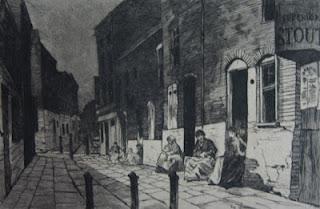 Auguste Lançon, Une ruelle dans SpitalfieldsEtching, 1884
Auguste Lançon, Une ruelle dans SpitalfieldsEtching, 1884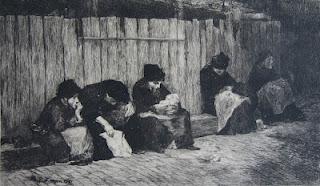 Auguste Lançon, Pauvresses accroupies contre le mur du "Workhouse" de Saint-GilesEtching, dated 1881 in the plate
Auguste Lançon, Pauvresses accroupies contre le mur du "Workhouse" de Saint-GilesEtching, dated 1881 in the plateBoth Vallès and Lançon were Communards, exiled in London after the fall of the ill-fated Paris Commune in 1871. Vallès was actually condemned to death, but escaped to England. Lançon spent six months imprisoned in the Satory camp - presumably in a similar cell to that of Philippe Cattelain - before joining Vallès in exile in London. Men such as Jules Vallès and Auguste Lançon were primed by their own experiences and deeply-held political beliefs to side with those in the underbelly of Victorian society, and rage against their plight. Both the text and etchings are very powerful evocations of the pitiful condition of the London poor, at the height of Britain's power and wealth, and it is a shame that La Rue à Londres seems so little known, presumably because it was never translated into English.
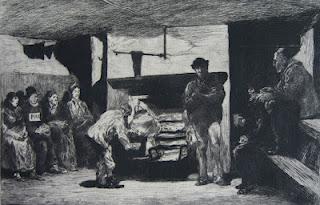 Auguste Lançon, Le soir dans un "Lodging-House" de Drury LaneEtching, dated 1880 in the plate
Auguste Lançon, Le soir dans un "Lodging-House" de Drury LaneEtching, dated 1880 in the plate Auguste Lançon, Un ménage d'émigrants Irlandais dans un "Lodging-House" de Drury LaneEtching, 1884
Auguste Lançon, Un ménage d'émigrants Irlandais dans un "Lodging-House" de Drury LaneEtching, 1884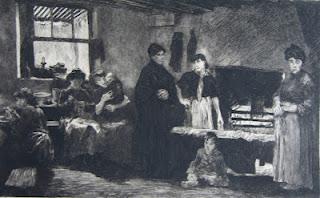 Auguste Lançon, La salle basse d'un "Lodging-House" de femmes dans Drury LaneEtching, 1884
Auguste Lançon, La salle basse d'un "Lodging-House" de femmes dans Drury LaneEtching, 1884Auguste Lançon is an artist I had previously come across largely as an accomplished etcher of animal scenes, so these London etchings come as something of a revelation. They are beautifully observed, often quite dark, and full of telling details. As records of the life of the London poor at this period, these remarkable etchings stand comparison with the wood engravings of Gustave Doré for Blanchard Jerrold's London.
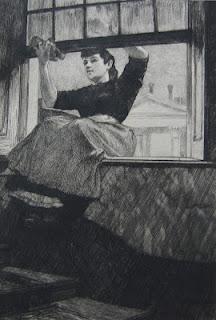 Auguste Lançon, La servante "The General Servant"Etching, 1884
Auguste Lançon, La servante "The General Servant"Etching, 1884 Auguste Lançon, La cuisineEtching, dated 1880 in the plate
Auguste Lançon, La cuisineEtching, dated 1880 in the plate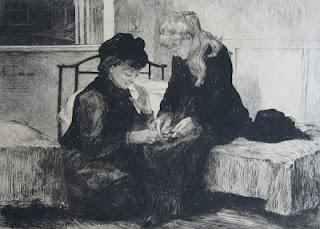 Auguste Lançon, Types de petites ouvrières dans leur intérieurEtching, 1884
Auguste Lançon, Types de petites ouvrières dans leur intérieurEtching, 1884Auguste André Lançon was born in 1836 in Saint-Claude in the Jura, the son of a carpenter. Lançon was first apprenticed to a lithographer in Saint-Claude, then studied at the École des Beaux-Arts de Lyon, and finally went to Paris to study under Picot. He first exhibited at the Salon de Paris in 1861, under the name André Lançon, which he continued to use until 1870.
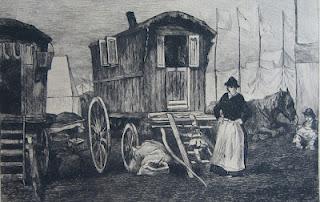 Auguste Lançon, Un campement de "Gypsies"Etching, 1884
Auguste Lançon, Un campement de "Gypsies"Etching, 1884When Lançon began exhibiting again in 1872, after the interruption of the Franco-Prussian War, the Commune, and imprisonment, it was as Auguste Lançon, and this switch of first names has led to confusion, with some writers assuming that André and Auguste were two different artists. La Rue à Londres credits him as A. Lançon, though most of the etchings are signed in the plate Aug. Lançon.
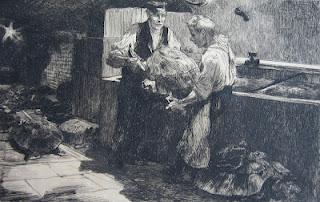 Auguste Lançon, Chez Painter le marchand de tortues - Les réservoirsEtching, 1884
Auguste Lançon, Chez Painter le marchand de tortues - Les réservoirsEtching, 1884La Rue à Londres was published by Georges Charpentier in an edition of 600 copies: 50 on Whatman with the etchings in two states, 50 on Japan, also with the etchings in two states, and 500 on wove paper, with the etchings in their final state. In all cases the etchings themselves were printed by either A. Salmon or F. Liénard on Hollande wove paper. The front cover claims 23 etchings, the title page 22, the latter being the correct total.

